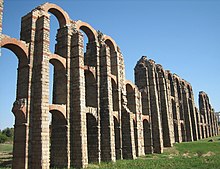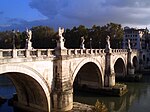| Revision as of 09:21, 13 October 2006 editNeddyseagoon (talk | contribs)Extended confirmed users, Pending changes reviewers139,074 editsmNo edit summary← Previous edit | Latest revision as of 13:25, 3 June 2024 edit undoFerclopedio (talk | contribs)Extended confirmed users13,466 edits reword | ||
| (74 intermediate revisions by 47 users not shown) | |||
| Line 1: | Line 1: | ||
| {{Short description|Aqueduct in Mérida, Spain}} | |||
| {{unreferenced}} | |||
| {{Infobox ancient site | |||
| | name = Aqueduct of the Miracles | |||
| | native_name = Acueducto de los Milagros | |||
| | native_name_lang = es | |||
| | image = El acueducto de Los Milagros.jpg | |||
| | caption = Aqueduct bridge | |||
| | type = ] | |||
| | location = ] (]), Spain | |||
| | material = ] and red brick | |||
| | coordinates = {{coord|38|55|28|N|6|20|48|W|region:ES|display=title, inline|format=dms}} | |||
| | embedded = | |||
| {{Designation list | |||
| | embed = yes | |||
| | designation1 = WHS | |||
| | designation1_offname = Los Milagros Aqueduct | |||
| | designation1_date = 1993 {{small|(17th ])}} | |||
| | designation1_partof = ] | |||
| | designation1_number = | |||
| | designation1_criteria = iii, iv | |||
| | designation1_type = Cultural | |||
| | designation1_free1name = Region | |||
| | designation1_free1value = ] | |||
| | designation1_free2name = Area | |||
| | designation1_free2value = {{convert|0.1177|ha|acre|abbr=on}} | |||
| | designation1_free3name = Buffer zone | |||
| | designation1_free3value = {{convert|20.9|ha|acre|abbr=on}} | |||
| | designation2 = Spain | |||
| | designation2_offname = Acueducto Romano "los Milagros" | |||
| | designation2_type = Non-movable | |||
| | designation2_criteria = Monument | |||
| | designation2_date = 13 December 1912 | |||
| | delisted2_date = | |||
| | designation2_partof = | |||
| | designation2_number = RI-51-0000112 | |||
| }} | |||
| }} | |||
| The '''Aqueduct of the Miracles''' is a ] in the Roman '']'' of ] –present-day ], Spain–, capital of the ] of ]. It was built during the first century AD to supply water from the ] into the city. After the fall of the ], the aqueduct fell into decay and today it is in ruins with only a relatively small section of the ] standing. It is part of the ], which is one of the largest and most extensive archaeological sites in Spain and that was declared a ] by ] in 1993. | |||
| '''Acueducto de los Milagros''' is a ] ] at ]. | |||
| ==Description== | |||
| ⚫ | ] | ||
| Only a relatively small stretch of the aqueduct still stands, consisting of thirty-eight arched pillars standing {{convert|25|m|ft}} high along a course of some {{convert|830|m|ft}}. It is constructed from ''opus mixtum'' – granite ] blocks interspersed with red brick – utilising a double arcade arrangement. The structure originally brought water to the city from a reservoir called the ], fed by a stream called Las Pardillas, around {{convert|5|km|mi|abbr=on}} to the north-west of Mérida.<ref>Roger Collins. ''Spain: An Oxford Archaeological Guide'', p. 195, 199. Oxford University Press, 1998. {{ISBN|0-19-285300-7}}</ref> | |||
| {{Ancient-Rome-arch-stub}} | |||
| It is thought to have been constructed during the 1st century AD, with a second phase of building (or renovations) around 300 AD. In later centuries, the inhabitants of Mérida dubbed it the "Aqueduct of the Miracles" for the awe that it evoked.<ref>"Study for the determination of the pathologies in the constituent materials of the Milagros Aqueduct (Mérida)", J.M. Ávila Macías, M.I. Mota López, I. Rodríguez Maribona, in ''Heritage, Weathering and Conservation: Proceedings of the International Heritage, Weathering and Conservation Conference (HWC-2006), 21–24 June 2006'', ed. Alvarez De Buergo. Taylor & Francis, 2006. {{ISBN|0-415-41272-2}}</ref> | |||
| The aqueduct was one of three built at Mérida, the other two being the {{convert|15|km|mi}} long Aqua Augusta, fed by the ], and ], fed by underground channels.<ref>Leonard A. Curchin. ''Roman Spain: Conquest and Assimilation'', p. 106. Routledge, 1991. {{ISBN|0-415-02365-3}}</ref> The aqueduct is preserved as part of the ], a ] ].<ref>{{cite web|title=Archaeological Ensemble of Mérida|url=https://whc.unesco.org/en/list/664/|publisher=UNESCO|date=19 March 2009|access-date=19 March 2009}}</ref> | |||
| In the immediate vicinity, a small Roman bridge called ] runs parallel to the arcades. | |||
| == See also == | |||
| *] | |||
| *] | |||
| *] | |||
| *] | |||
| == References == | |||
| {{Reflist}} | |||
| == External links == | |||
| {{Commons category-inline}} | |||
| {{Archaeological Ensemble of Mérida}} | |||
| {{World Heritage Sites in Spain}} | |||
| {{Roman aqueducts|state=collapsed}} | |||
| {{Roman bridges|state=collapsed}} | |||
| {{Authority control}} | |||
| {{DEFAULTSORT:Milagros, Acueducto de los}} | |||
| ⚫ | ] | ||
| ] | |||
| ] | |||
| ] | |||
| ] | |||
| ] | |||
| ] | |||
Latest revision as of 13:25, 3 June 2024
Aqueduct in Mérida, Spain| Acueducto de los Milagros | |
 Aqueduct bridge Aqueduct bridge | |
| Location | Mérida (Badajoz), Spain |
|---|---|
| Coordinates | 38°55′28″N 6°20′48″W / 38.92444°N 6.34667°W / 38.92444; -6.34667 |
| Type | Roman aqueduct |
| History | |
| Material | Granite and red brick |
| UNESCO World Heritage Site | |
| Official name | Los Milagros Aqueduct |
| Type | Cultural |
| Criteria | iii, iv |
| Designated | 1993 (17th session) |
| Part of | Archaeological Ensemble of Mérida |
| Reference no. | 664-001 |
| Region | Europe and North America |
| Area | 0.1177 ha (0.291 acres) |
| Buffer zone | 20.9 ha (52 acres) |
| Spanish Cultural Heritage | |
| Official name | Acueducto Romano "los Milagros" |
| Type | Non-movable |
| Criteria | Monument |
| Designated | 13 December 1912 |
| Reference no. | RI-51-0000112 |
The Aqueduct of the Miracles is a Roman aqueduct in the Roman colonia of Emerita Augusta –present-day Mérida, Spain–, capital of the Roman province of Lusitania. It was built during the first century AD to supply water from the Proserpina Dam into the city. After the fall of the Roman Empire, the aqueduct fell into decay and today it is in ruins with only a relatively small section of the aqueduct bridge standing. It is part of the Archaeological Ensemble of Mérida, which is one of the largest and most extensive archaeological sites in Spain and that was declared a World Heritage Site by UNESCO in 1993.
Description
Only a relatively small stretch of the aqueduct still stands, consisting of thirty-eight arched pillars standing 25 metres (82 ft) high along a course of some 830 metres (2,720 ft). It is constructed from opus mixtum – granite ashlar blocks interspersed with red brick – utilising a double arcade arrangement. The structure originally brought water to the city from a reservoir called the Proserpina Dam, fed by a stream called Las Pardillas, around 5 km (3.1 mi) to the north-west of Mérida.
It is thought to have been constructed during the 1st century AD, with a second phase of building (or renovations) around 300 AD. In later centuries, the inhabitants of Mérida dubbed it the "Aqueduct of the Miracles" for the awe that it evoked.
The aqueduct was one of three built at Mérida, the other two being the 15 kilometres (9.3 mi) long Aqua Augusta, fed by the Cornalvo reservoir, and San Lázaro, fed by underground channels. The aqueduct is preserved as part of the Archaeological Ensemble of Mérida, a UNESCO World Heritage Site.
In the immediate vicinity, a small Roman bridge called Puente de Albarregas runs parallel to the arcades.
See also
- List of aqueducts in the Roman Empire
- List of Roman aqueducts by date
- Ancient Roman technology
- Roman engineering
References
- Roger Collins. Spain: An Oxford Archaeological Guide, p. 195, 199. Oxford University Press, 1998. ISBN 0-19-285300-7
- "Study for the determination of the pathologies in the constituent materials of the Milagros Aqueduct (Mérida)", J.M. Ávila Macías, M.I. Mota López, I. Rodríguez Maribona, in Heritage, Weathering and Conservation: Proceedings of the International Heritage, Weathering and Conservation Conference (HWC-2006), 21–24 June 2006, ed. Alvarez De Buergo. Taylor & Francis, 2006. ISBN 0-415-41272-2
- Leonard A. Curchin. Roman Spain: Conquest and Assimilation, p. 106. Routledge, 1991. ISBN 0-415-02365-3
- "Archaeological Ensemble of Mérida". UNESCO. 19 March 2009. Retrieved 19 March 2009.
External links
![]() Media related to Acueducto de los Milagros at Wikimedia Commons
Media related to Acueducto de los Milagros at Wikimedia Commons
| Archaeological Ensemble of Mérida | ||
|---|---|---|
| UNESCO World Heritage Site | ||
|  | |
| Roman aqueducts | ||
|---|---|---|
| Croatia |  | |
| France | ||
| Germany | ||
| Italy | ||
| Jordan | ||
| Luxembourg | ||
| Spain | ||
| Tunisia | ||
| Turkey | ||
| United Kingdom | ||

